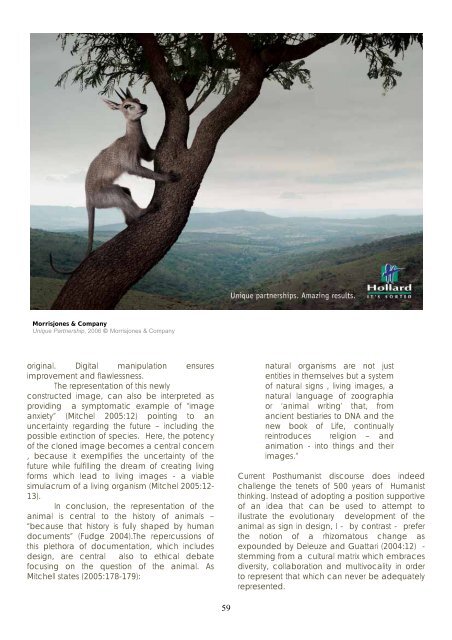Marketing Animals - Antennae The Journal of Nature in Visual Culture
Marketing Animals - Antennae The Journal of Nature in Visual Culture
Marketing Animals - Antennae The Journal of Nature in Visual Culture
You also want an ePaper? Increase the reach of your titles
YUMPU automatically turns print PDFs into web optimized ePapers that Google loves.
Morrisjones & Company<br />
Unique Partnership, 2006 Morrisjones & Company<br />
orig<strong>in</strong>al. Digital manipulation ensures<br />
improvement and flawlessness.<br />
<strong>The</strong> representation <strong>of</strong> this newly<br />
constructed image, can also be <strong>in</strong>terpreted as<br />
provid<strong>in</strong>g a symptomatic example <strong>of</strong> “image<br />
anxiety” (Mitchel 2005:12) po<strong>in</strong>t<strong>in</strong>g to an<br />
uncerta<strong>in</strong>ty regard<strong>in</strong>g the future – <strong>in</strong>clud<strong>in</strong>g the<br />
possible ext<strong>in</strong>ction <strong>of</strong> species. Here, the potency<br />
<strong>of</strong> the cloned image becomes a central concern<br />
, because it exemplifies the uncerta<strong>in</strong>ty <strong>of</strong> the<br />
future while fulfill<strong>in</strong>g the dream <strong>of</strong> creat<strong>in</strong>g liv<strong>in</strong>g<br />
forms which lead to liv<strong>in</strong>g images - a viable<br />
simulacrum <strong>of</strong> a liv<strong>in</strong>g organism (Mitchel 2005:12-<br />
13).<br />
In conclusion, the representation <strong>of</strong> the<br />
animal is central to the history <strong>of</strong> animals –<br />
“because that history is fully shaped by human<br />
documents” (Fudge 2004).<strong>The</strong> repercussions <strong>of</strong><br />
this plethora <strong>of</strong> documentation, which <strong>in</strong>cludes<br />
design, are central also to ethical debate<br />
focus<strong>in</strong>g on the question <strong>of</strong> the animal. As<br />
Mitchell states (2005:178-179):<br />
59<br />
natural organisms are not just<br />
entities <strong>in</strong> themselves but a system<br />
<strong>of</strong> natural signs , liv<strong>in</strong>g images, a<br />
natural language <strong>of</strong> zoographia<br />
or ‘animal writ<strong>in</strong>g’ that, from<br />
ancient bestiaries to DNA and the<br />
new book <strong>of</strong> Life, cont<strong>in</strong>ually<br />
re<strong>in</strong>troduces religion – and<br />
animation - <strong>in</strong>to th<strong>in</strong>gs and their<br />
images.”<br />
Current Posthumanist discourse does <strong>in</strong>deed<br />
challenge the tenets <strong>of</strong> 500 years <strong>of</strong> Humanist<br />
th<strong>in</strong>k<strong>in</strong>g. Instead <strong>of</strong> adopt<strong>in</strong>g a position supportive<br />
<strong>of</strong> an idea that can be used to attempt to<br />
illustrate the evolutionary development <strong>of</strong> the<br />
animal as sign <strong>in</strong> design, I - by contrast - prefer<br />
the notion <strong>of</strong> a rhizomatous change as<br />
expounded by Deleuze and Guattari (2004:12) -<br />
stemm<strong>in</strong>g from a cultural matrix which embraces<br />
diversity, collaboration and multivocality <strong>in</strong> order<br />
to represent that which can never be adequately<br />
represented.












